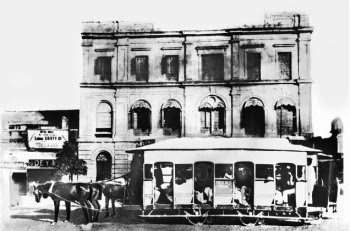+River,+Nashik,+Maharashtra+-+India+1928.JPG) |
Photo: Bathing Ghat,
Godavari River (Nasik – 1924)
|
I happened to visit my home town Kolkata last year and any journey without a tram ride would be incomplete. Few days ago when I was recollecting on Kolkata tram ride, the nostalgia grew on me and I began to research more about the history of trams in India. I typed the words “Trams in India” on Google and what I discovered left me shocked.
Did You Know: Our own city
Nasik had a tramway till the 1930’s!!!
The British
occupied Nasik towards the second decade of 19 century. In 1818, the Nasik
district area completely came under British rule. Nasik was given the status of
a town and municipal council was established in 1865. Even in this period Nasik
continued to be a religious centre. Brahmin community of Nasik was very influential.
The British administration on many occasions had to bow to the wishes of Brahmin
community. Construction of Railway line joining Mumbai was the most significant
development of the 19-century. But Brahmins opposed its entry into Nasik city
on religious
 |
Photo: The first horse-drawn tram (Kolkata – 1880)
|
Calthrop requested
leave in 1886 to investigate proposals for independent branch lines. He
identified two schemes of particular interest, a 5-mile (8.0 km) tramway
connecting the Hindu religious centre of Nasik with the railway, and a 21-mile
(34 km) branch line to the town of Barsi.
 |
| Photo : Early horse-drawn
trams in India (similar to Nasik) |
The Great
Indian Peninsula Railway approved both schemes, and Calthrop undertook a survey
of both lines. In 1887 he registered the Indian Railways Feeder Lines Company
in London to promote the construction of feeders to the railway. The Great
Indian Peninsula Railway suggested that he either returned to his duties as a
locomotive inspector, or, with their support, resign to further promote branch
lines. His health was failing, and so in 1889 Calthrop resigned from the Great
Indian Peninsula Railway. Working as a consultant he then supervised the
construction of the 2 ft 6 in (762 mm) gauge
horse-powered Nasik Tram.
This
tramway was constructed in 1889 with a capital of 1 lakh rupees. Originally,
the tramway used two carriages pulled by four horses. It originated from what is now the Old
Municipal Corporation building located on Main Road, and terminated at the
Nasik Road railway station (a distance of around 8–10 km). It is said to pass
through areas of Ganjamal (the now defunct bus stop was
earlier a tram stop) and behind the Fame Multiplex. Brady’s; a private company
funded the project and later introduced India’s first petrol engine driven tram
under the aegis of Nasik Tramway Co. The tramway closed down in around 1933 owing
to the successive years of famine and plague, it had run into heavy losses.
 |
| Photo : Tram passing through a residential area. (Year Unknown) |
Other
Indian cities which had tram services:
Kolkata (24 February 1873-present)
Mumbai (9
May 1874 - 31 March 1964)
Delhi (6
March 1908 - 1963)
Chennai (7 May 1895 - 12 April 1953)
Kanpur (June 1907 - 16 May 1933)
& Patna (unknown – 1903)
Sources: wikipedia.org and other websites.
